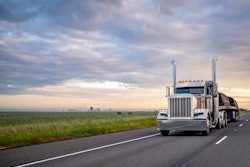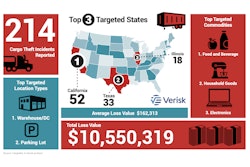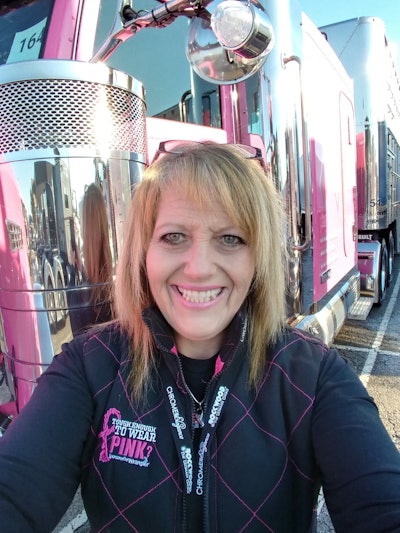 Pamela Cox hauls pigs for Radebaugh Inc. and has been hauling livestock for 32 years.
Pamela Cox hauls pigs for Radebaugh Inc. and has been hauling livestock for 32 years.Editor’s Note: This is the second installment in a two-part series on livestock hauling. See the first part about cattle hauling.
Pamela Cox of Pandora, Ohio, has moved cattle, horses, pigs, sheep, goats, buffalo and even deer, but she now primarily hauls pigs. She drives for Radebaugh Inc. and has been hauling livestock for 32 years.
Hauling pigs, as well as goats and sheep, generally pays better than cattle, says Cox, in line with the industry saying, “little feet, big money.” However, the market for those animals isn’t as large as the cattle market, she says. Before she settled into her pig run, Cox hauled cattle in Texas.
“Last year, I cleared $52,000 and didn’t work nearly as hard as I have in 27 years in Texas, where I was lucky if I cleared $43,000,” Cox says.
Most producers load and unload their pigs, which takes that pressure off the driver. “It takes longer to load pigs, because you can only bring them up in, like, groups of six,” Cox says. “If you’re lucky, you may be able to get 12 to come out.” Sometimes a loader is used to lift the pigs into the trailer.
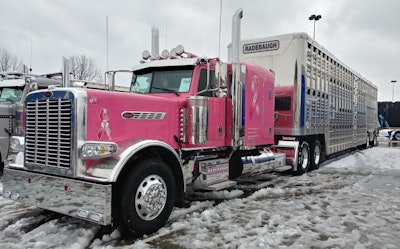 Pig hauler Pamela Cox drives this 2016 Peterbilt 389, named “Pinkie” because of its exterior and breast cancer awareness decals. She pulls a 2018 Wilson livestock trailer.
Pig hauler Pamela Cox drives this 2016 Peterbilt 389, named “Pinkie” because of its exterior and breast cancer awareness decals. She pulls a 2018 Wilson livestock trailer.Pigs struggle to regulate their body temperature, so haulers can’t stop for long during the summer. “Pigs don’t sweat, so you have to keep moving and keep air on them,” Cox says. Likewise, trailers may need boarding up in the winter to keep pigs warm, often more than what cattle would require in a similar situation.
Pigs also differ from cattle in that their behaviors don’t vary so much. Because they are smaller, they are easier on equipment, not trying to kick holes in the trailer like cattle or buffalo will, Cox says. “They will sooner squeal at you and run than kick.”
HAULING BEES
Husband-and-wife team Bud and Aneisha Chapel of Pocatello, Idaho, operate SS Olson LLC, hauling bees with a 2018 Kenworth T680 and a Western 48-foot step-deck trailer. When they started six years ago, they shadowed other bee haulers.
“They trained us a lot, but then we just started watching every load and talking to the beekeepers,” Bud says.
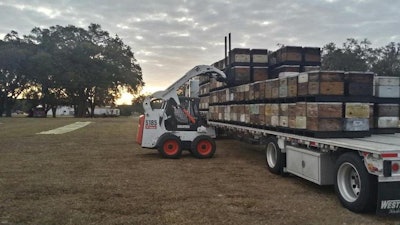 Bud and Aneisha Chapel don bee suits when they load hives onto their trailer. The husband-and-wife team drives a 2018 Kenworth T680.
Bud and Aneisha Chapel don bee suits when they load hives onto their trailer. The husband-and-wife team drives a 2018 Kenworth T680.Bees are loaded in boxes containing hives but are free to fly out, so Bud and Aneisha wear protective bee suits while loading and unloading. Once they’re loaded securely, a net is thrown over the bees.
The Chapels always load at sunset because that’s when the bees are calmest. For the same reason, the Chapels fuel only in the morning or at night, making a point not to stop during daylight hours.
During hot weather, bees are loaded to keep the wind directly on them to keep them calm. The Chapels keep a water hose on their truck and water the bees when they park at night. Should the truck stop for a daytime emergency, the hauler also will spray water on them to keep them calm.
If it’s below 20 degrees, they put a small face tarp on the load’s front to block the coldest wind while allowing air to circulate from the sides. When parking in subfreezing temperatures, the Chapels find two reefers or other trucks to park between so the bees don’t get too cold.
“We try to haul specific to the bees’ needs instead of our needs,” Bud says.
Most bee hauling chases the pollination opportunities in certain areas over about nine months, with each haul running two or three days. Demand falls off in July and August because of honey production, so the Chapels usually take time off then. Around February, there’s another slow period because many bees are in California for pollinating.
The Chapels usually run four to 12 weeks at a time. “When the bees are on, the bees are on, and you just don’t go home,” Bud says.
Bud says bee hauling compensation averages out with what the broader trucking industry sees, though with more time off. If customers are willing to pay more for a more experienced bee hauler, pay can be higher, but the slow seasons tend to bring the annual earnings closer to trucking industry averages.








